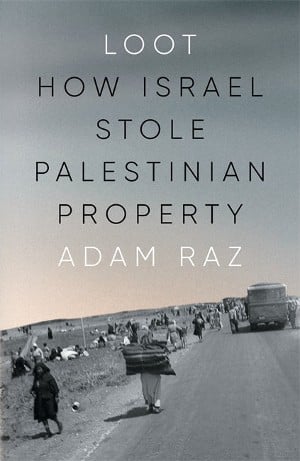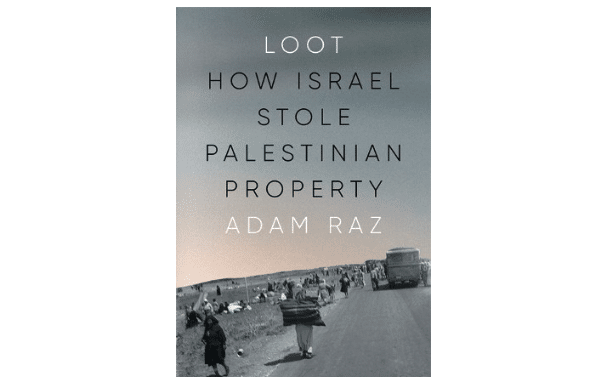Adam Raz has made an important addition to the study of the ethnic cleansing of Palestine in this detailed volume containing original research. The book focuses on the theft of Palestinian property after the owners were driven from their land and homes between April and May 1948.

Adam Raz, Loot: How Israel Stole Palestinian Property (Verso 2024), 352pp.
Raz is an historian and human-rights researcher/activist who works for Akevot, a non-profit human-rights organisation in Israel. Akevot is dedicated to finding solutions to the ‘Israel-Palestine Conflict’ (their words). And the mission statement of Akevot helps to explain the way in which Raz has gone about writing Loot.
We make archives a tool for change by researching and exposing mechanisms, processes and events who play a role in the perpetuation of the Conflict. We assist human rights defenders and civil society organizations in accessing archival documentation relevant to their work. We campaign to expand the public’s access to government archives to promote transparency and freedom of information.
Access to archives is an important issue in Israel because they are controlled by the state and the IDF. Researchers are increasingly struggling to gain access to material for the period 1945-49 where the bloody details of Israel’s founding are held. As a result, details of the theft of Arab lands and possessions are denied to historians and their readers. Adam Raz has to be credited with writing a book with irrefutable evidence that breaks down the ‘conspiracy of silence’ surrounding Israel’s foundation and counters Zionist claims about Palestinians leaving their country of their own free will.
The strength of Loot lies in its impressive detail. Raz has used some thirty separate archives to detail the scale of looting, including material from the state and IDF archives that was already extant. Some of the material has been used before, like the diaries and letters of Ben-Gurion and other leading Zionists, but much is new. In particular, archives from the kibbutzim have provided much detail about what and how much was stolen, and the amounts are staggering.
Loot has two parts. Part 1 is dedicated to the detailed account of pillaging and Part 2 deals with the socio-political consequences of it. The limited objectives of the book, simply to present overwhelming evidence of widespread pillaging by Jewish militia and settlers, limits the political impact it has. For example, although Raz makes it clear that he is not considering the theft of Palestinian land and is focusing on moveable property, this is to ignore the most important theft that the Palestinians suffered. It was the theft of land through terror that allowed and encouraged the pillaging to take place. Similarly, there is nothing on the role of Britain and the imperialist powers whose role in enabling Zionist terror should be included.
Raz explains the rationale of his approach (pp.7-8) by distinguishing the theft of land and buildings from moveable property because the decision to steal land was taken at the political level, whereas the pillaging was undertaken by the former neighbors of those dispossessed. The pillaging of neighbours’ property shaped Jewish attitudes of hostility towards remaining Palestinians, and changed how Jews thought about themselves.
Part 1
The first part of the book details the pillaging of the main urban centres such as Tiberias, Haifa, Jerusalem, Jaffa, and then moves on to detail the pillaging of Palestinian villages, mosques and churches.
The pillaging followed a pattern in the context of what Raz calls ‘the 1948 War’ rather than the Nakba. Once Arab fighters were killed or fled, the military groups established control over towns and established a form of order. Nominally, pillaging was forbidden, but the soldiers regarded anything they fancied to be legitimate booty. Within hours sometimes, Jewish settlers poured into abandoned property and began to pillage systematically what was left. The theft was weaponised, with the objective of removing the desire to return from the exiled Palestinians.
Raz includes the testimony of those Jews who objected to the looting. For example, the Haifa Workers’ Council published an appeal that bemoaned the break-up of mixed and mutually supportive communities: ‘For years and years we have lived together peacefully in Haifa, our city, and have interacted with each other with understanding and as brothers …’ (p.38). The effects on the dispossessed were agonising, as a whole lifetime’s possessions were lost. In Jerusalem, a Palestinian exile remembered, ‘We left the house, the clothes, the furniture, the library, the food, the giant piano that knew no equal, and the electric refrigerator’ (p.54).
It is impossible to read about the scale of the plunder, and the desecration of Arabic cultural artefacts, that included book burnings, without recalling what befell Jews in Europe in the 1930s and 40s. It was a conscious attempt to wipe out the identity of a people, and yet it also serves to remind us what a wealthy land Palestine was.
Shops and warehouses were obvious targets. Goods were stolen in bulk and sold on the black (and not so black) market. Jewish settlers who had not managed to acquire wealth to this point suddenly found themselves with the opportunity to open businesses. The Jewish economy got a massive boost and the desire to live as neighbours declined.
There are many passages that show the Israeli paramilitary groups aping the behaviour of pogromists in a previous time. In Beersheba, a Negev Brigade commander recalled; ‘Noise and the sound of breaking mirrors filled the streets, pieces of broken furniture flew through the air, and black smoke filled the sky. Pillows, blankets and garments, canned food and weapons for souvenirs—the looters left nothing untouched … commanders lost control of their soldiers’ (p.152).
Jewish farmers made significant gains that, in turn, stimulated the desire to drive out remaining Palestinian farmers. They targeted farms and agricultural warehouses seizing tractors, timber, irrigation pumps and seeds. From here, the demand was inevitably going to be for more land and the exclusion of Arab produce from Jewish markets. As Raz makes clear; ‘In this way, over the course of a few months, soldiers and civilians alike plundered thousands of villages across the country. The tools and the daily bread of both “present” and “absent” Palestinian peasants were stolen and destroyed. They could no longer return to their destroyed homes’ (p.204).
Part 2
The second part of the book is about the economic, political and cultural outcomes of the looting. In broad terms, the participating Jewish settlers became stakeholders in the newly founded country with a material interest in preventing the return of dispossessed Palestinians and extending Jewish claims to Palestinian lands.
The extent of the criminality and the involvement of both civilian and military actors laid the foundation for policies of exclusion and segregation. The first chapter in Part 2 is titled, ‘A Poison Spreading through the Veins of Society’, which sums up this section rather neatly. Many respectable figures were horrified by the extent of the criminality and believed that it had corrupted the moral character of country. The kibbutzim, for example, wereup to their necks in the looting frenzy. However, the dissenting voices ran up against the military leaders who saw plunder as an essential ideological weapon in the war.
Raz concludes that senior political and military figures forbade looting de jure but permitted it de facto. He quotes Tuvyah Cohen, who, after studying the criminal roles of the two Israeli military groups, the Irgun and the Haganah, argued; ‘The only possible conclusion that can be drawn is that leading institutions gave free rein to things’ (p.225).
In all honesty, this is not a profound conclusion for anyone with knowledge of the period, but it probably does contribute to the those looking for answers in the current ferment of Israeli politics. And nor should it surprise us to find that the villain at the centre of the plunder was none other than Israel’s first Prime Minister, David Ben-Gurion.
Ben-Gurion was the one with ‘the strongest historical instincts’ and wanted the great acts of theft to be carried out far from the public gaze. There is a very useful section on how Nazareth was spared the fate of other cities because of its connection to the Christian faith. Ben-Gurion instructed commanders there only to enter the city with trusted personnel and to be prepared to use machine guns on any troops that disobeyed orders (p.281).
Overall, Adam Raz has written a book that successfully provides the evidence to break through the ‘conspiracy of silence’ about the origins of the Israeli state. Critics are bound to slight Loot for not being hard enough on Zionism, not having enough Palestinian testimony, and, most glaringly, the omission of the crimes of the imperial powers. This is all fair comment. However, the book was written with the purpose of getting Israelis to look honestly at their history in the hope that this will become part of the national discourse.
It is impossible to say if this ambition will succeed, however, I would recommend it to all those who are fighting for Palestine to be free and for an end to war. As Adam Raz concludes; ‘Internal redemption can only be created by gazing directly at the brutal face of truth. I hope this book makes a modest contribution to this’ (p.320).
John Westmoreland is a history teacher and UCU rep. He is an active member of the People’s Assembly and writes regularly for Counterfire.

